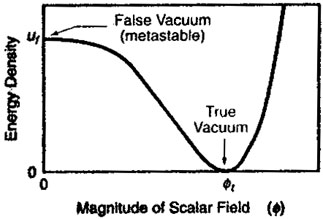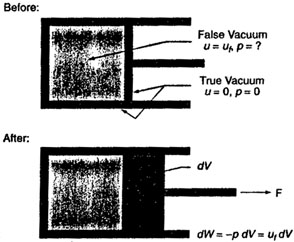


Although the properties of the Big Bang are very special, we now know that the laws of physics provide a mechanism that produces exactly this sort of a bang. The mechanism is known as cosmic inflation.
The crucial property of physical law that makes inflation possible is the existence of states of matter that have a high energy density that cannot be rapidly lowered. Such a state is called a "false vacuum," where the word "vacuum" indicates a state of lowest possible energy density, and the word "false" is used to mean temporary. For a period that can be long by the standards of the early Universe, the false vacuum acts as if the energy density cannot be lowered, since the lowering of the energy is a slow process. The underlying physics of the false vacuum state is described in the box on the left.
Critical Mass Density and Flatness
THE CRITICAL MASS density
 c related
to the Hubble constant H by
c related
to the Hubble constant H by
where G is Newton's gravitational constant). The quantity
The spatial geometry of the Universe is determined by the quantity
If this quantity exceeds one, the Universe curves back on itself to
form a closed space of finite volume, but without boundary In such a
space the sum of the angles in a triangle would exceed 180 degrees,
and a starship traveling on a straight line would eventually return to
its point of origin. If the quantity above is less than one, the
Universe is an open space in which triangles contain less than 180
degrees. If the quantity is exactly one, the space is Euclidean, which
is also called flat.
Physics of the False Vacuum
THE FALSE VACUUM arises naturally in any theory that contains scalar
fields, that is, fields that resemble electric or magnetic fields
except that they have no direction. The Higgs fields of the Standard
Model of particle physics or the more speculative grand unified
theories are examples of scalar fields. It is typical of Higgs fields
that the energy density is minimal not when the field vanishes, but
instead at some nonzero value of the field. For example, the energy
density diagram might look like
The energy density is zero if
The peculiar properties of the false vacuum stem from its pressure,
which is large and negative (see box on the right). Mechanically such
a negative pressure corresponds to a suction, which does not sound
like something that would drive the Universe into a period of rapid
expansion. The mechanical effects of pressure, however, depend on
pressure differences, so they are unimportant if the pressure is
reasonably uniform. According to general relativity, however, there is
a gravitational effect that is very important under these
circumstances. Pressures, like energy densities, create gravitational
fields, and in particular a positive pressure creates an attractive
gravitational field. The negative pressure of the false vacuum,
therefore, creates a repulsive gravitational field, which is the
driving force behind inflation.
There are many versions of inflationary theories but generically they
assume that some small patch of the early Universe somehow came to be
in a false vacuum state Various possibilities have been discussed,
including supercooling during a phase transition in the early
Universe, or a purely random fluctuation of the fields. A chance
fluctuation seems reasonable even if the probability is low, since the
inflating region will enlarge by many orders of magnitude, while the
non-inflating regions will remain microscopic. Inflation is a wildfire
that will inevitably take over the forest, as long as there is some
chance that it will start.
Once a patch of the early Universe is in the false vacuum state, the
repulsive gravitational effect drives the patch into an inflationary
period of exponential expansion. To produce a universe with the
special features of the Big Bang discussed above, the expansion factor
must be at least about 1025. There is no upper limit to the
amount of expansion. Eventually the false vacuum decays, and the
energy that had been locked in it is released. This energy produces a
hot, uniform, soup of particles, which is exactly the assumed starting
point of the traditional Big Bang theory. At this point the
inflationary theory joins onto the older theory, maintaining all the
successes for which the Big Bang theory is believed.
In the inflationary theory the Universe begins incredibly small,
perhaps as small as 10-24 cm, a hundred billion times smaller
than a proton. The expansion takes place while the false vacuum
maintains a nearly constant energy density, which means that the total
energy increases by the cube of the linear expansion factor, or at
least a factor of 1075. Although this sounds like a blatant
violation of energy conservation, it is in fact consistent with
physics as we know it.
The resolution to the energy paradox lies in the subtle behavior of
gravity. Although it has not been widely appreciated, Newtonian
physics unambiguously implies that the energy of a gravitational field
is always negative a fact which holds also in general relativity. The
Newtonian argument closely parallels the derivation of the energy
density of an electrostatic field, except that the answer has the
opposite sign because the force law has the opposite sign: two
positive masses attract, while two positive charges repel. The
possibility that the negative energy of gravity could balance the
positive energy for the matter of the Universe was suggested as early
as 1932 by Richard Tolman, although a viable mechanism for the energy
transfer was not known.
During inflation, while the energy of matter increases by a factor of
1075 or more, the energy of the gravitational field becomes
more and more negative to compensate. The total energy - matter plus
gravitational - remains constant and very small, and could even be
exactly zero. Conservation of energy places no limit on how much the
Universe can inflate, as there is no limit to the amount of negative
energy that can be stored in the gravitational field.
This borrowing of energy from the gravitational field gives the
inflationary paradigm an entirely different perspective from the
classical Big Bang theory, in which all the particles in the Universe
(or at least their precursors) were assumed to be in place from the
start. Inflation provides a mechanism by which the entire Universe can
develop from just a few ounces of primordial matter. Inflation is
radically at odds with the old dictum of Democritus and Lucretius,
"Nothing can be created from nothing" If inflation is right,
everything can be created from nothing, or at least from very
little. If inflation is right, the Universe can properly be called the
ultimate free lunch.
Pressure of the False Vacuum
THE PRESSURE OF THE FALSE VACUUM can be determined by a simple
energy-conservation argument. Imagine a chamber filled with false
vacuum, as shown in the diagram below.
For simplicity, assume that the chamber is small enough so that
gravitational effects can be ignored. Since the energy density of the
false vacuum is fixed at some value uf, the energy
inside the chamber is U=ufV, where V
is the volume. Now suppose the piston is quickly pulled outward,
increasing the volume by dV. If any familiar substance were
inside the chamber, the energy density would decrease. The false
vacuum, however, cannot rapidly lower its energy density, so the
energy density remains constant and the total energy increases. Since
energy is conserved, the extra energy must be supplied by the agent
that pulled on the piston. A force is required, therefore, to pull the
piston outward, implying that the false vacuum creates a suction, or
negative pressure p. Since the change in energy is dU =
ufdV, which must equal the work done, dW =
-pdV, the pressure of the false vacuum is given by
The pressure is negative, and extremely large. General relativity
predicts that the gravitational field which slows the expansion of the
universe is proportional to uf + 3p, so the negative
pressure of the false vacuum overcomes the positive energy density to
produce a net repulsive gravitational field.
 c =
3H2 / 8
c =
3H2 / 8 G
G
 is
defined by
is
defined by  =
=
 /
/
 c, where
c, where
 is the actual mass
density. It is often assumed that the cosmological constant
is the actual mass
density. It is often assumed that the cosmological constant
 introduced by Einstein is
zero, in which case the Universe will recollapse if and only if
introduced by Einstein is
zero, in which case the Universe will recollapse if and only if
 >
1. If
>
1. If  is non-zero, the
condition for recollapse is more
complicated, but the equation above is still taken as the definition
of
is non-zero, the
condition for recollapse is more
complicated, but the equation above is still taken as the definition
of  c.
c.
 +
+
 / 3H2
/ 3H2

 =
=
 t, so this condition
corresponds
to the ordinary vacuum of empty space. In this context it is usually
called the "true" vacuum. The state in which the scalar field is near
t, so this condition
corresponds
to the ordinary vacuum of empty space. In this context it is usually
called the "true" vacuum. The state in which the scalar field is near
 = 0, at the top of the plateau,
is called the "false" vacuum. If
the plateau of the energy density diagram is flat enough, it can take
a very long time, by early Universe standards, for the scalar field to
"roll" down the hill of the energy density so that the energy can be
lowered. For short times the false vacuum acts like a vacuum in the
sense that the energy density cannot be lowered.
= 0, at the top of the plateau,
is called the "false" vacuum. If
the plateau of the energy density diagram is flat enough, it can take
a very long time, by early Universe standards, for the scalar field to
"roll" down the hill of the energy density so that the energy can be
lowered. For short times the false vacuum acts like a vacuum in the
sense that the energy density cannot be lowered.
